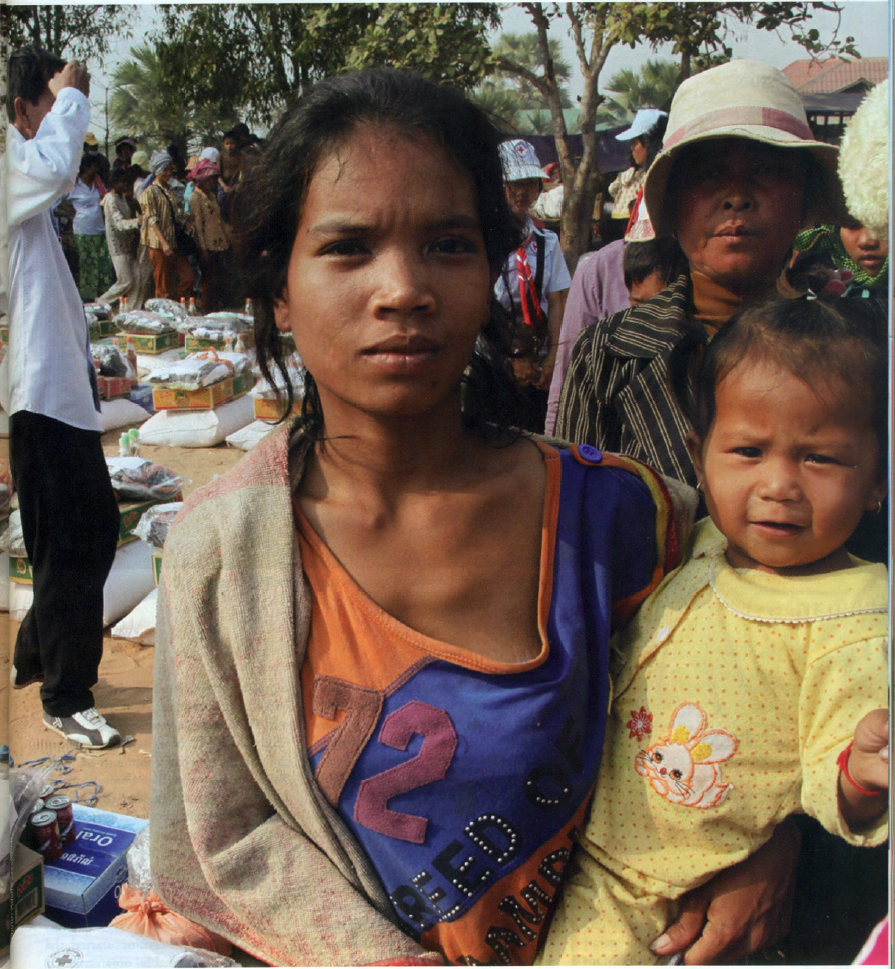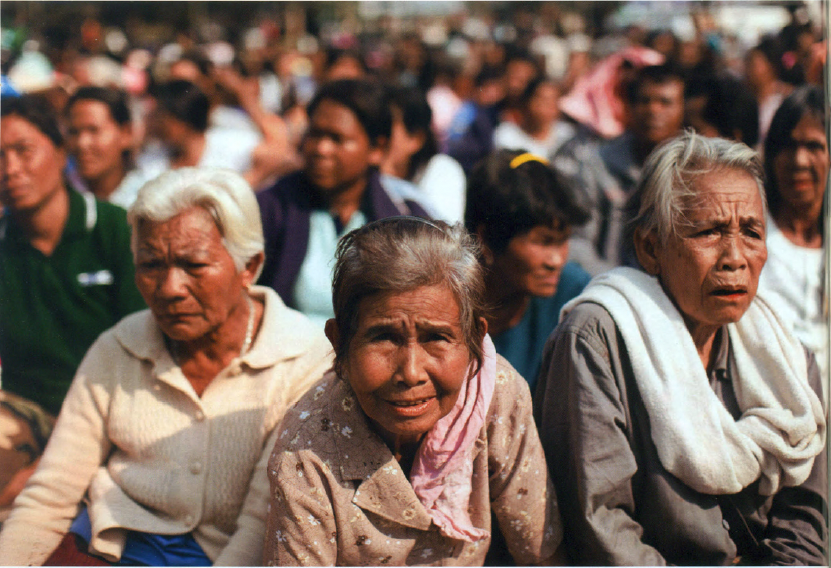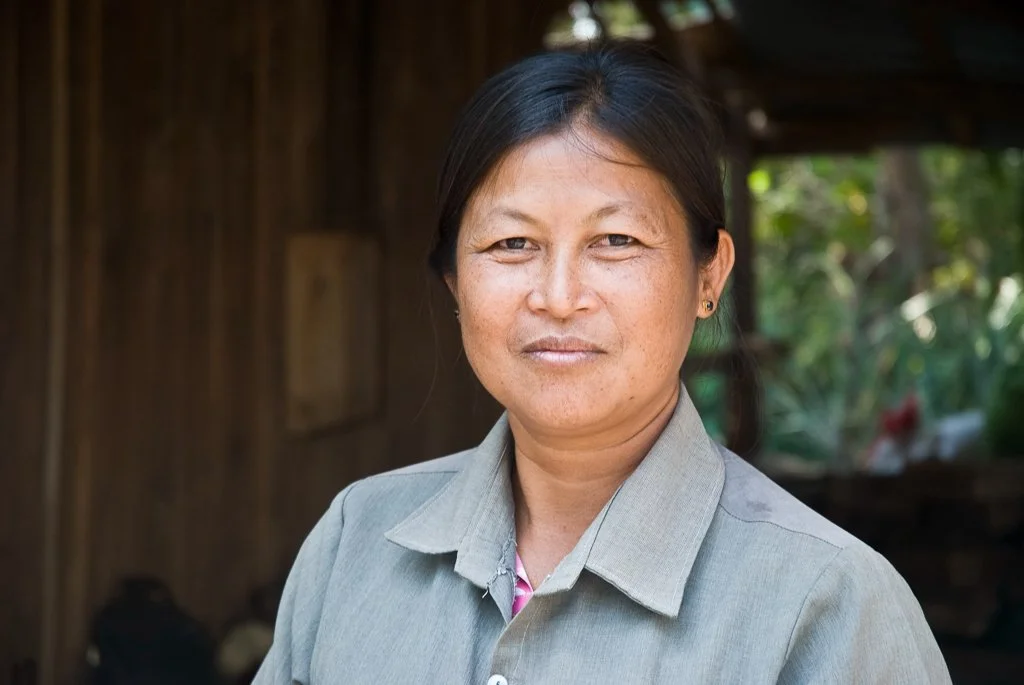In the line of fire
Once again civilians are paying the price of unresolved conflict.
Southeast Asia Globe, March 2011
Safe distance. Cambodian refugees seek assistance in Takeung Military Base.
The rockets that fell near Choam Khsan on the night of February 4 instantly woke Phay Chanthan and her daughters. Terrified and confused, they ran into the forest to take cover. They’d brought nothing with them, but cleared a space on the ground and tried to sleep, not daring to return home. “I was so frightened that even though I was worried about poisonous snakes, it was only a fear within a fear. It didn’t change how I felt:’ Chanthan said.
The next day, she and her daughters, aged 7 and 15, marched six kilometres until they found military transport to a refugee camp in Kulen. They joined as many as 24,000 people escaping the border conflict that had flared up again with Thailand near the famed 11th century Angkorian temple at Preah Vihear. This was the latest engagement in a proprietorial dispute that goes back decades, resulting in confrontations in 2001 and 2008. The military actions that starred last month, however, have been the most serious to date.
A week later, in the nearby forest around Sa Em, the village of Boran stood deserted, with only dogs around to keep guard. The roads were flanked by a forest blackened by flame to make hunting and logging easier, lending an apocalyptic feel not strictly warranted. Rockets had fallen in the nearby village of Thoma Cheat, putting many people to flight. So Serei, who refused to flee because he was afraid of being looted, recalls vividly the terrible sound. As we talk, a policeman stops to ask if we’ve seen three rockets he’s misplaced. Back in Sa Em village, a woman explains that the ex-Khmer Rouge are not afraid of war; they don’t run.
Lost peace. Thai villagers gather in Sisaket province, which borders Cambodia,
after the conflict intensified last month.
Many husbands stay behind to protect their property and businesses. She joined them. For those who fled, the National Committee for Disaster Management moved into action, mobilising the support of several NGOs. Four camps were originally established at Kulen, but by the time the United Nations Security Council went into session on February 14, they had consolidated into just one, at Takeung military base.
Chanthan, originally from Kampong Cham, remembers the day she arrived. She had already spent three days at another camp, making this her third move in a week. “When I came here, I was very surprised because it was so crowded in the camp, but they already had health clinics and all the refugees are organised very well. I’m pleased;’ she said.
On the banks of Sen River, Takeung camp runs about half a kilometre long and 300 metres wide and is home to about 2,300 families. Higgledy-piggledy improvised tents, made of blue PVC sheets stretched over bamboo, branches, trailers and motos, provide a very rudimentary shelter for the thousands of families sitting in wait beneath them. There is no order in the layout; strewn litter and scruffy bushes add to the disarray.
Yellow mellow: distribution centre in makeshift refugee camp at Takeung military base.
Safety first: fleeing from rockets, Phay Chanthan walked six kilometres before being picked up by a military convoy.
Ten days after the hostilities started, the camp seems remarkably organised. Dr Yim Yaren, a senior operations manager for World Vision Cambodia, agrees. “Everything is well managed and the NGOs have contributed many things. The government did very well.” A water supply is in place, and medical services and distribution of food and equipment such as plates, water purifiers, pots and toiletries are functioning. A lively market has sprung up and many individual traders have gone home to collect their businesses and bring them here. There are coffee shops and sugar cane squeezers, and a light smell of smoke hangs in the air from all the cooking fires.
Children run between the tents, while the adults mostly sit in the shade, waiting patiently. An old lady passes by selling milk fruit so she can go to the pagoda and make an offering. Loud music plays from somewhere in the middle of it all.
But no matter how well run, life is still not easy. “It’s very difficult living here. It’s really hot in the day and there is nothing to do, only sitting around waiting, bored, looking at other people:’ said Mis Nang, from Boran Village, as she tried to coax medicine down her daughter’s throat.
One Sunday night, a big storm passed over the camp. Very few of the tents actually reach the ground and almost everyone was exposed to the lashing rains. Many children have since contracted fevers and coughs, including Mis Nang’s baby. “At night, too, it’s humid, which isn’t good for her health;’ she said. According to Save the Children, more than 6,500 boys and girls have been sheltering in the camps in Preah Vihear. If their parents are no strangers to conflict, most of the children mercifully have no such memories, which makes it all the more difficult. Long Sokha, a provincial education officer for the organisation, said: “The kids are lonely. Their parents are frightened and they’re not used to seeing them that way.”
Close quarters: Temporary shelter for Cambodian civilians at Takeung.
The NGOs are working to create spaces for the children to play and learn. Not all of them go, however, and Lour Trod’s grubby-faced progenies watch us dolefully while their mother explains how two families are living under one tent that is at most three metres by three metres in size. Last week, four families slept under this same roof “The children are not happy,” Lour Trod said. “It’s hot and they have to sleep on the ground. We all feel different since we got here.”
Despite the strong sense of everything being organised, a protest broke out on February 15 when people complained that late arrivals were getting less support than those who had arrived earlier in the week. Kean Sambo, also from Sa Em, explained that families who arrived later received only one support package each, while early arrivals got one for every family member. “The last to arrive are the poor people. They don’t have transport and the local taxis have all increased their prices;’ he said. “The military tuna is not so good, either.”
Although they want to go, no one talks about when it might happen. ‘I don’t trust Thailand’ was a virtually unanimous response. “I must stay here, because if I go back, it’s more dangerous;’ said Mis Nang. Chanthan, whose husband is a soldier, agrees. “Preah Vihear is important, but lives are important too. I hope that they find an agreement so that we can go back home.”
It may not be that simple. The Cambodian Mine Action Centre (CMAC) and other observers have confirmed reports that Thailand has used cluster munitions – a report that Thailand denies. It will take weeks to assess the contamination and months before the land can be cleared. For the displaced, the wait goes on.
Below are a couple of other photos I took while reporting on this story.
Rockets fell on this logging community near Sa Em (Sah I'm). A few people wandered around the otherwise deserted village. They were mostly men who had come back from the refugee camps to collect items they would need to feed and shelter their families while away. Other than that, only the dogs remained.
Tough days ahead. The camps were well run, but it was a bewildering time for a lot of the children who were unused to the upheaval that was so much a characteristic of their parents' lives. It wasn't all bad. Government officials and aid agencies worked hard to ensure the children felt safe and comfortable.








